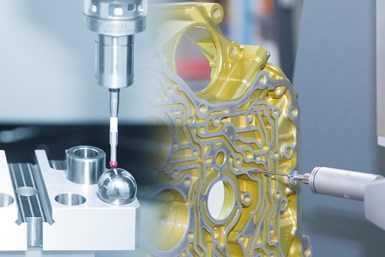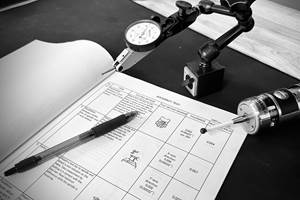Rethink Quality Control to Increase Productivity, Decrease Scrap
Verifying parts is essential to documenting quality, and there are a few best practices that can make the quality control process more efficient.
Share




Over many years in the industry, I have noticed a few things that I believe need to change in machine shops. This column describes one that has been bothering me for a long time: quality control. I know this may ruffle a few feathers, but how we do quality control needs to change.
The standard practice that I see in most machine shops is that when a machine is set up, the first parts are sent to quality control for inspection and verification. The machine usually sits idle until the green light of approval is given by the quality control department, which can take a while depending on how busy the department is. Then, once the green light is given, the machinists boot up the machines and start making parts. Intermittently throughout the production process, sample parts are sent to quality control to verify that they are still within specifications.
Despite the fact that machine operators are measuring parts manually, there are usually features they will have difficulty measuring, as the equipment necessary to make these intricate measurements can only be found in the quality control room. If quality control personnel detect a problem, then the manufacturing equipment is stopped, the process is corrected and the suspected nonconforming parts need to be quarantined and sorted — parts that are nonconforming are usually scrapped.
I have seen this process play out in many shops, and over the years it has begun to bother me because it seems so wasteful in terms of time and productivity. Verifying parts is essential to documenting quality, but there needs to be a better practice that will increase productivity while decreasing scrap.
The first practice deals with in-process measuring at the machine level — the CNC part-making machine should be doing the measuring. Machine tool manufacturers should be integrating a measuring system at the design level into the machine tool. I know there are after-market products that can be integrated, but they are an add on. Add ons usually have their own issues, including software compatibility and placement, which sometimes make these systems very difficult to work with.
When a machine tool manufacturer builds the parts measuring system into the machine, the placement of probes and software is more integrated. This makes it easier to do in-process inspection on an active basis since the machine tool was designed to do this from the start. It will also enable for integrated recording of measurements since it can be built in. Integrated recording is key, as it enables machine shops to have automatic documentation without needing machine operators to do it. It will also allow the machine to adjust itself to keep parts in tolerance, which would decrease scrap.
Following this practice is not going to eliminate all inspections, but it would seriously increase productivity and quality.
The other practice is to move the quality control department closer to the manufacturing equipment. There are now shopfloor CNC measuring machines that are accurate and compact. They can be brought closer to the machines so that setup people and operators can measure their parts quicker and in-process without having to constantly walk over to the quality control room. If the quality control room is at the other end of the building, then the journey is long and wasteful. Having the quality control room nearer to the machines would get production up and going faster by eliminating the time spent going between the two.
I believe that the quality control department is there to verify that parts are made to the drawing — it is there as a resource for the shop. That being said, quality control must start at the machine and end on the shop floor. Yes, there will always be a department where temperature-controlled measurements of hard-to-measure features will have to made, but the primary quality control must be at the shopfloor level.
In this competitive world, we need to make parts faster and with higher quality. This is why we need to make changes to the quality control department. Start with machine tools that have in-process integrated measurement capabilities that produce documentation with high-quality inspection machines. To increase productivity, these machines need to be readily accessible to shopfloor personnel. This is how we can move manufacturing and quality control to the next level.
Related Content
Ballbar Testing Benefits Low-Volume Manufacturing
Thanks to ballbar testing with a Renishaw QC20-W, the Autodesk Technology Centers now have more confidence in their machine tools.
Read More4 Ways to Establish Machine Accuracy
Understanding all the things that contribute to a machine’s full potential accuracy will inform what to prioritize when fine-tuning the machine.
Read MoreHow to Evaluate Measurement Uncertainty
Manufacturing and measurement are closely coupled. An important consideration for the use of measurement results is the associated measurement uncertainty. This article describes common metrology terms and provides an example uncertainty analysis.
Read MoreThe Link Between CNC Process Control and Powertrain Warranties
Ever since inventing the touch-trigger probe in 1972, Sir David McMurtry and his company Renishaw have been focused on achieving process control over its own manufacturing operations. That journey has had sweeping consequences for manufacturing at large.
Read MoreRead Next
Setting Up the Building Blocks for a Digital Factory
Woodward Inc. spent over a year developing an API to connect machines to its digital factory. Caron Engineering’s MiConnect has cut most of this process while also granting the shop greater access to machine information.
Read More5 Rules of Thumb for Buying CNC Machine Tools
Use these tips to carefully plan your machine tool purchases and to avoid regretting your decision later.
Read MoreBuilding Out a Foundation for Student Machinists
Autodesk and Haas have teamed up to produce an introductory course for students that covers the basics of CAD, CAM and CNC while providing them with a portfolio part.
Read More































